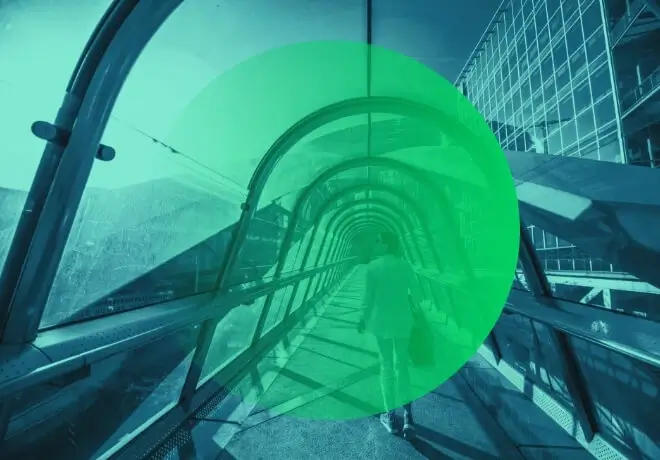30 . 06 . 2020
GOOD PRACTICE Business continuity plan - why your company should have it
30 . 06 . 2020
The pandemic has made companies aware that although it is impossible to predict all the black scenarios, having a solid business continuity plan sometimes makes a difference between “to be” and “not to be”.
When in March 2020 it turned out that remote work was a necessity, we were ready. We went into home-office mode almost overnight, and soon our office building closed completely. After establishing communication channels and weekly inter-departmental meetings to discuss current events, we became one hundred percent virtual.
Administration, IT support, customer support, sales, marketing – every area of our work was now functioning online, and we didn’t even know when we would be able to return to the office. Not until two months had passed that we started our slow returnal to the company, and we are still not able to gather the entire team there late June due to security regulations. How will we remember this challenging period?
We know that not all companies offer a digital product, and thus, are not able, at least in theory, to smoothly switch to work in remote mode. After all, it’s hard to expect a furniture manufacturer to suddenly abandon production lines and switch to selling three-dimensional CAD models of his products, unless, of course, they decide to tailor the offer to the needs of The Sims fans. However, even while observing the digital market, we saw how much difference a well-structured business continuity plan makes. The peace of mind, which is one of our core values, could not take a more tangible form.
BCP - Beware the seemingly insignificant oversights
The pandemic has made us look very carefully at the level of organization in the company. BCP (business continuity plan) usually assumes adequate prevention of the risk of losing business continuity – and the epidemic is one of the main factors preventing business operations. In such a situation, it is worth remembering not only about securing the supply chain or providing personal protective equipment for employees, but also, which is not so obvious, about tools such as an electronic signature, the lack of which can drastically limit the decision-making of the company’s management board when the physical contact of its members is limited or impossible.
It is also important to properly train employees, familiarize them with the procedures, set duties to be performed when disruption of business continuity occurs and plan many other issues. What difficulties a company may face
we often learn only when they appear right in front of us. Meanwhile, many BCP issues can (and should) be considered in advance. For example, it is worth asking yourself whether the company knows how to comply with the provisions of the GDPR while working remotely? Do employees use secure networks when working from home? Do we have optimal MDM (mobile device management) solutions at place? Indeed, in connection with the restrictions that were forced upon them, entrepreneurs were most surprised by administrative and technological issues.
So, the better the business continuity management system is implemented, the smaller the financial losses for the company and the more room for maneuver when difficulties arise. In no case is this an unnecessary effort, which has been confirmed in the last few months numeorous times.
ITCP - IT departments are "inherently" better prepared for the difficulties
Looking at the continuity plans of IT systems, companies are usually much better prepared in this regard. IT Continuity Plan is a standard somewhat inscribed in the functioning of the IT department. This is a well-known saying that the work of an IT team is based on putting out fires and patching holes. Therefore, IT departments relatively easily adapted to remote work (in a sense, they work in this mode on a daily basis). Procedures in case, for example, the server will fail or the system will detect a threat, they must be developed on an ongoing basis, therefore the pandemic and the need for remote work were not a major challenge for IT departments.
However, good ITCP is not just backup and VPN for engineers. It is primarily the entire Disaster Recovery infrastructure, to which we can switch our systems in the event of a backup infrastructure failure, preferably several hundred kilometers away, which further minimizes the risk of failure in both server rooms simultaneously.
One of the important parameters of the IT Continuity Plan is also RPO. RPO (recovery point objective), i.e. a data recovery point, e.g. at the level of 15 minutes, means that data from the main server room is copied to the backup server room every quarter of an hour, so in the event of a failure of the main server, the client will lose work progress from the last quarter at a maximum.
In turn, the RTO (recovery time objective) parameter means the time necessary to switch the service to a backup environment (Disaster Recovery). Designing RPO and RTO consider various failure scenarios and develop detailed procedures, and then test them with the team, so you’ll be prepared for (almost) every situation.
FORDATA Disaster Recovery Plan - the strength of preparation
Due to the fact that we operate in the industry of confidential information protection, we care for security and business continuity very precisely. In the end, the liquidity of proceedings in our clients’ deals, often multi-million-dollar, is at stake. During 11 years we have developed strict rules of conduct. Our Business Continuity Coordinator describes the recently implemented continuity tests as follows:
“We have created the opportunity for team members to practice roles and responsibilities, as well as the possibility of group discussion on procedures. We wanted individual people not only to be prepared to carry out their tasks in the event of a failure, but also that the customer service team had the opportunity to ask questions that the project team may not have asked themselves before. We wanted everyone to understand the so-called “Big picture”. We regularly update procedures to ensure continuity and conduct retests every year.”
This year our continuity tests took place just before the pandemic. The tests involved an almost completely different team from the one who developed the original assumptions, and yet we did not encounter major difficulties.
Since we run tests regularly, and any incidents that occur during the course of each “review” seal our system even more in case of difficulties, we are confident that even a pandemic will not interrupt users at work. And this is the main goal of the entire undertaking.
And the VDR system itself is, in a sense, a component of business continuity plan of our customers’. With its help, any company will be able to smoothly transfer processes requiring confidentiality into remote mode, such as obtaining crediting, restructuring, auditing, conversations with contractors and lawyers, working on sensitive documents and many others. The need to work remotely does not have to involve the suspension or cancellation of projects involving external partners and clients of the company. They can be effectively run in a Data Room. Read more on how to choose a Virtual Data Room effectively.
We all want to believe that a pandemic as surprising as the COVID-19 will not be repeated but in spite of this preparation of BCP should not be postponed. Any delay in operations and inability to make decisions, as in the case of a pandemic, means business losses. And this is just one of the reasons why BCP should always be there.
Did you like the article?

How many heads, so many ideas. That's why each of us contributes to making the content on our blog attractive and valuable for you. Discover a source of knowledge and inspiration for your business with Fordata.
Do you want to exchange knowledge or ask a question?
Write to me : #FORDATAteam page opens in new window
Complete your BCP with FORDATA Virtual Data Room
TRY FOR FRE Get your trial version for free-
01 . Serial M&A acquisitions in a nutshell - good practices and technology

Both serial and single buy-side M&A processes play an important role in companies’ development strategies. However, they differ in purpose, scale and approach, which determines their importance for the company.
15.07.2024
-
02 . Fake software aggregators – how to identify them?

Fake software aggregators and Virtual Data Room industry. See how developers try to deceive their customers with fake software comparison websites.
14.03.2024
-
03 . Safe alternative to Dropbox in Due Diligence

Why should I pay for VDR when I can use Dropbox?’ – our clients ask this question sometimes. Yet the answer is not that straight…
26.01.2024
-
04 . Transformations and challenges: European fintech in 2023

The European Fintech ecosystem, once characterized by rapid growth and numerous investments, has undergone significant changes and challenges in 2023. Where does the sector currently stand?
16.11.2023
-
05 . Public-Private Partnership (PPP) in Poland

Public-Private Partnership (PPP) – optimizing budgetary expenses and efficient collaboration between the public and private sectors. Explore the benefits and key elements of joint PPP projects.
09.11.2023
-
06 . Energy industry 2023: Virtual Data Room in M&A transactions

The situation in the energy industry in Poland and Central and Eastern Europe is rapidly changing. What do investments in renewable energy look like?
06.06.2023
-
07 . VDR in due diligence process

M&As are a permanent element of the economic world. Their goal is to achieve strategic and financial benefits by expanding markets, diversifying products and production processes.
27.05.2023
-
08 . What documents can you load to data room?

Virtual Data Room is a great alternative to applications like Dropbox and Google Drive, especially when it comes to security…
13.03.2023
-
09 . Company audit - how does it work?

It can be inevitable and often it causes irrational fear. In fact, it is a great opportunity to help your business grow. An audit in a company is always a serious undertaking.
09.02.2023
-
10 . Venture Capital and Private Equity - the differences between the funds

PE/VC – what are the differences between Private Equity and Venture Capital funds? We point at the main characteristics of both.
15.06.2022
-
11 . Fundraising - how to obtain financing with the VDR tool?

Acquiring financing is a process that requires proper planning based on the current economic conditions, especially in times of crisis…
26.05.2022
-
12 . Who is obliged by DORA and how?

DORA regulation is another step of the EU into operational resilience of financialentities. Who does in concern?
19.05.2022
-
13 . Secure sharing of company documents. A guide for entrepreneurs.

The growing expectations of users regarding the ease and availability of online solutions are one of the main drivers of the digital revolution.
15.04.2022
-
14 . FORDATA system reports - all news in a nutshell

The new version 5.0 of the FORDATA system has been well-received by our users. Working in VDR has become even faster…
14.04.2022
-
15 . How to improve document workflow - 5 rules

Desks full of binders and busy employees with cardboard folders in their hands – these are classic pictures, especially known from…
25.11.2021
-
16 . Audit during the pandemic - how has it changed?

The epidemic has had a significant impact on the economy and the functioning of companies, therefore its effects…
27.01.2021
-
17 . FMCG industry - how do companies adapt to the market?

The FMCG industry is trying to make up for the losses lockdowns caused in numerous European countries, while selling of consumer goods…
18.12.2020
-
18 . The scale of restructuring is different in each industry. What about Automotive?

Coronavirus will have long-term effects on the economy. The results of the annual balance sheet may result in some companies not starting restructuring until next year.
22.09.2020
-
19 . Restructuring and the pandemic - accelerated digitalization

Market closure due to the COVID-19 pandemic has intensified the restructuring efforts of many companies. The phenomenon…
20.05.2020
-
20 . Are your email attachments safe?

The modern office cannot function without email. According to the Radicati group, a statistical employee receives 121 messages per…
02.03.2020
-
21 . How to black out text in a PDF document correctly?

Document redaction has many faces – it may turn out that overwriting of the text in our document, which at first glance looks…
27.02.2020
-
22 . Safe cloud and the user - a marriage of convenience

According to a report on cloud computing prepared by McAfee, up to 87% of the companies surveyed believe that…
03.02.2020
-
23 . Virtual Data Room as a green solution

Entrepreneurs increasingly use ecological solutions and try to implement them almost in all areas of the company’s operation…
25.11.2019
-
24 . 5 startup tips from FORDATA

Learn 5 startup ideas that may help your project set off – from first-hand startupers! Read our tips that can help your project get off to a good start.
19.11.2019
-
25 . Top 4 Advantages of VDR over FTP server

Even today, FTP server is a popular method of transferring files. With its help, we can quickly share virtually any type of…
18.09.2019
-
26 . Cloud Data Storage And File Security

The internet has become a common thing in companies’ lives. The enormity of dedicated services, fast transfers and increasing mobility…
31.07.2019
-
27 . How FORDATA Data Room Works?

Are you interested in how the VDR project works in FORDATA? What is our secret of delivering excellent customer service? We have previously…
12.07.2019
-
28 . FORDATA Competitive Advantage – Customer Support

Have we already mentioned that we are available 24/7/365? At FORDATA we are extremely flexible…
12.07.2019
-
29 . Due Diligence stages - selling your business step by step

Every good investment decision is based on sound knowledge about a given company and transaction process. This applies…
25.06.2019
-
30 . Due Diligence - what exactly does it include?

What does Due Diligence investigation consist of? Who performs it? What are its types? Find the answers to these and other questions on FORDATA blog!
18.06.2019
-
31 . Due Diligence audit using Virtual Data Room - security in your company

The process of sharing confidential information can be greatly improved by using Virtual Data Room. Preparing for an audit?
14.01.2019
-
32 . Virtual Data Room: Everything you need to know

What is a virtual data room? What benefits can we achieve by using the system in merger and acquisition transactions?
25.10.2017
-
33 . FORDATA - Outstanding Customer Service!

FORDATA Team is flexible and understands your needs. Exceptional customer support distinguishes us among competitors.
21.09.2017
-
34 . GPG standard - a word on encrypting confidential data

Some users want it 101% safe. If the files we share via cloud services really need that extra layer of protection, encrypting them with a GPG standard might be a good idea.
13.07.2016
-
35 . Vendor Due Diligence - the Value of Negotiation Preparation

Vendor Due Diligence (VDD) is carried out only for the needs of the seller, which means that it takes place earlier than Due Diligence (DD).
09.11.2015



